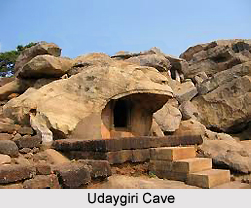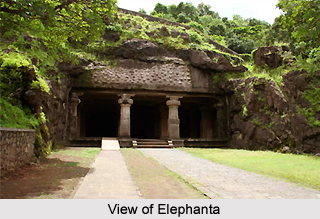 Post-Gupta period-later rock-cut temples sculptures in India far excel the rest of the world in rock-cut architecture, of which the handpicked memorials were built during the two and a half centuries, from c. 55 to 800. The prime caves are located at Elephanta, Jogesvari, Mandapesvar, Kanheri, in the subrubs of Mumbai, Aurangabad and nearby Ellora Caves in Maharashtra (ancient Vidarbha), Badami and Aihole in Karnataka. The earliest are direct descendants of the Vataka Caves in Ajanta, and it is definitely exceedingly likely that generations of stone-cutters and sculptors travelled from one site to another in Konkan, western Maharashtra, and other parts of western Deccan, determined possibly by the consecutive waves of subjugations by the Kalachuris, the early western Chalukyas, and finally the Rashtrakutas, who went on to suppress the whole region. The Hindu and even Jain caves and temples brought out innovative and rather dissimilar ground plans and detailed sculptural creations, exemplifying myths from the Indian Puranas influencing the later Buddhist caves and giving rise to a more affluent and more luxuriant iconography. Novel sculptures, primarily of Buddhas and Bodhisattvas, were established in many of the earlier caves, especially at Karle, Nasik and Kanheri. Of the monolithic replications of structural temples, cut out of solid rock at the closing stages of the period, the enormous Kailasanatha at Ellora is the utmost triumph.
Post-Gupta period-later rock-cut temples sculptures in India far excel the rest of the world in rock-cut architecture, of which the handpicked memorials were built during the two and a half centuries, from c. 55 to 800. The prime caves are located at Elephanta, Jogesvari, Mandapesvar, Kanheri, in the subrubs of Mumbai, Aurangabad and nearby Ellora Caves in Maharashtra (ancient Vidarbha), Badami and Aihole in Karnataka. The earliest are direct descendants of the Vataka Caves in Ajanta, and it is definitely exceedingly likely that generations of stone-cutters and sculptors travelled from one site to another in Konkan, western Maharashtra, and other parts of western Deccan, determined possibly by the consecutive waves of subjugations by the Kalachuris, the early western Chalukyas, and finally the Rashtrakutas, who went on to suppress the whole region. The Hindu and even Jain caves and temples brought out innovative and rather dissimilar ground plans and detailed sculptural creations, exemplifying myths from the Indian Puranas influencing the later Buddhist caves and giving rise to a more affluent and more luxuriant iconography. Novel sculptures, primarily of Buddhas and Bodhisattvas, were established in many of the earlier caves, especially at Karle, Nasik and Kanheri. Of the monolithic replications of structural temples, cut out of solid rock at the closing stages of the period, the enormous Kailasanatha at Ellora is the utmost triumph.
History of Post-Gupta period-later rock-cut temples
In the 4th century AD as the Gupta Empire ushered in; a new era began in India. With the commencement of the Gupta period, India stepped into the classical sculptural form. The art technique enhanced in perfection, explicit types came into life, and standards of exquisiteness progressed with accuracy. No experimentation and no groping in the dark evolved. The remarkable images were formed with a brilliant and in-depth grasping of the important art standards. Also, an advanced sense of aestheticism and an excellent finishing by expert artists resulted in the fashioning of these images. In the subsequent ages, these images served as the ideal for the artists.
The serenity and simplicity of Gupta sculpture made it renowned. The zenith of development was marked by this style of sculpture. This sculpture equated between the sullied sensuality of Kushan period and emblematic abstraction of the later period. The Gandhara and Mathura schools have some foreign influence on them. This influence is vanished from the Gupta art of sculpture and turned it entirely Indian in nature. The Gupta style of sculpture in India represents the talent of creativity that existed during the time of Gupta dynasty.
 Legends of Gupta Sculpture
Legends of Gupta Sculpture
India has always held massive buildings. Luxurious paintings and architectures of these buildings have the capacity to make the beholder astonished. An idiom of its own was developed by the Gupta Empire for having erected monuments and sculptures. The characteristics of the sculptures of the Guptas were diligently followed by the artists of that era.
Among the legendary sculptures of the Gupta Empire, the name of the structural temples at Kanchipuram in the state of Tamil Nadu and The Elephanta cave temples near Mumbai, Maharashtra.
The sculptures from Vidisha and the nearby Udaygiri Caves in Madhya Pradesh are the first recorded sculptures in an early style of Gupta sculpture. They were built in the Mathura tradition in the second half of the 4th century.
Universal accomplishment was attained during the period of the Gupta Empire. This was a classical age. The course of the art was determined by the evaluation of form and taste. It was during this time when the religious architecture was very popular. No wonder, the Buddhist and Jain temples were constructed all through the Gupta dominion. Also, the more convoluted images of the Mahayana pantheon came into existence. Apart from them, the Ajanta cave frescoes were also there. Excellence of the brilliant craftsmanship is epitomized in the temples and sculpture of Gupta period. The temples that house sculptural elements such as the Yakshas and the Nagas were replaced as independent cult images except rare cases by the Gods and Goddesses of both the grand cults of theism.





















